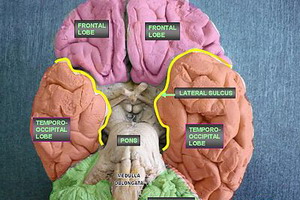 Comes from the Greek: agnôsia. It is an etymological combination of the Greek words: a-(negation) – gnosie (knowledge).
Comes from the Greek: agnôsia. It is an etymological combination of the Greek words: a-(negation) – gnosie (knowledge).
The agnosia is a cognitive disorder manifested by a lack of recognition ability (he does not know). The affected subject perceives the stimuli, but does not at the logical level. The agnosia is not a disorder of the design language.
Etiology
Stroke, ischemia. Brain injury of primary areas. Epilepsy: syndrome of Landau-Kleffner giving an acquired verbal auditory agnosia. Dementia.
There are several kinds of agnosies.
Visual agnosies
The ability of Visual recognition deficit. Lesion at the level of the occipital lobe and Visual associative areas.
- Inability or difficulty to recognize faces: Prosopagnosia (proso – face)
- Impossibility of recognition of color: achromatopsia
- Impossibility of recognition of the words (letters) written: Alexie agnosique
The deficit of the perception of forms aperceptive agnosia. The name of an object is impossible. The subject does not have access to the meaning of the object in question (inability to know what it is).
There are 3 types of aperceptives agnosies:
The form agnosia is the inability to discriminate against the basic geometric shapes, the integrative agnosia is the absence of coherent global integration of information. The agnosia of transformation: the patient may describe an object that from his point of view (it can not describe it as if he saw aside, for example)
The perception of the form associative agnosia is normal but the perception of the meaning of the object is reduced. There are the semantic agnosia of the (hardly visible) semantic access agnosia.
Hearing agnosies
Lesion at the level of the temporal lobes, associative auditory areas. This may be the lack of understanding of the spoken language.
The somatosensory agnosies or touch
the astéréognosie is a deficit of “stéréognostique sense”, in relation to the touch. Patients have difficulties to recognize objects using, texture, size, or weight. They remain able to describe verbally to visually recognize objects in the same category and draw them. The astéréognosies are due to damage to cortical somatosensory (lobe average).
Amorphognosie – problem of recognition of the size and the shape of the object.
Ahylognosie – problem of recognition of weight, texture, density and temperature of the object.
It is possible to have a left or right unilateral tactile agnosia.
The asomatognosies
The body image disturbance.
The Non-conscience of its own disorders anosognosia. Hémiasomatognosie kinesthetic Hallucinations, non-recognition of his own body. A paralyzed member is considered foreign, it is the “phenomenon of the third hand”. the non-awareness of his illness and his disorder apraxognosie
Space agnosies
Hemineglect frequent Syndrome that appears after focal brain injury of the hemisphere parietal, much more frequent, lasting and severe on the right than left. The orientation of spatial attention disorder. The patient ignores partially or completely the elements of space located on the side opposite to the lesion. This disorder involves all the senses. Attentionnelle Hemineglect following a lesion of the V1 visual cortex in the occipital lobe, the patient loses consciousness of the Visual hémichamp of the hemisphere contralateral injured. This disorder is detectable by the request of reproduction of a simple drawing by the patient; It is then that reproduced half of the original drawing.
The Visual function remains intact in this disorder: the eye sees, cerebral analysis of the information collected is always (detection of the movement, reflex avoidance of an object launched by the pseudo-aveugle side of the patient), but the patient has lost conscious access to the sense. Hemineglect centred on the object Hemineglect retino-centered relative neglect at the ocular fixation. Hemineglect egocentric héminéglicence relative to the body of the subject and independent of the eye fixation point relative to the gravitational axis gravitational Hemineglect up-down.





















